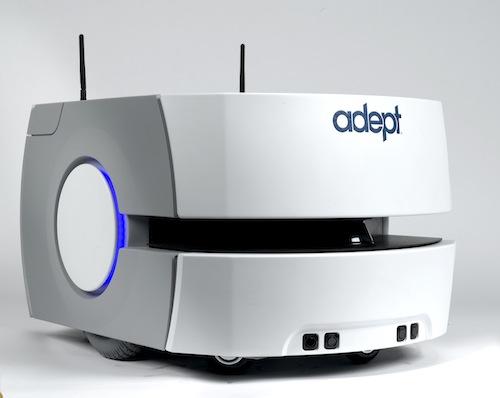New Class of Mobile Industrial Robots
February 25, 2013

A new category of mobile robots -- what Adept Technology is calling an autonomous indoor vehicle (AIV) -- uses a localization and navigation engine to enable self-driving operation in indoor plant and warehousing environments. The technology is designed to allow material handling equipment to behave as mobile robots and to enable lean manufacturing operations.
"With regard to key areas of technology differentiation, most engineers are familiar with how automated guided vehicles operate," Rush LaSelle, vice president and general manager of MobileRobots for Adept Technology, told us.
Many AGVs require beacons or magnets in the floor, so there is an up-front cost associated with modifying the facility for the use of an AGV.
But equally important is that AGVs tend to stay on a fixed path, so if it runs into congestion with other AGVs, or a worker inadvertently left a pallet on the floor, the AGV stops. One of the areas where we can differentiate our AIV technology is its ability to navigate better within the factory.

One place this type of mobile robot could make a big impact is in order-picking applications. Companies like Amazon have miles of racking and millions of products. When a customer places an order, it could include a bowling ball from one end of the facility and a toothbrush from the other end. In such a case, an AGV would need to move on a fixed track all the way from one end of the facility (to pick up the bowling ball) to the other. "If you really think about the difference compared to AGVs," LaSelle said, "they are following a bus route, and we are operating like a point-to-point taxicab."
If you take the differentiation one level of abstraction further, Adept has spent a lot of development time on its Enterprise Manager. This software -- effectively middleware on an appliance between robots in a fleet -- would allow companies like Amazon to tell the robots what items are needed and where they need to be delivered.
We do all the management of which robot is available in the closest proximity, which has the best battery charge and is really ideal for the mission at hand. We also do the management of all the traffic between all of them and the queuing. All of that functionality is in a black box that ultimately provides customers a straight conveyance or transfer functionality from an ERP system.
Here are some use cases for manufacturing and warehousing.
Line-side fulfillment: Automating the movement of goods from a warehouse or staging area to an assembly or production line, robots would be used in place of forklifts or handcarts. Mobile platforms would use a small piece of conveyor or a robot to transfer parts or containers on to and off of the vehicle for movement around a facility.
Work piece movement: Complex and large products such as durables or automobiles tend to move linearly on assembly lines. Manufacturers are looking to use robots to move the vehicles to promote flexibility in how assemblies are routed through a plant. For example, an automobile affixed to a large AIV would be routed through cellular manufacturing areas, where either manual or automated processes would be carried out.
Replacing conveyor or overhead transports: In production facilities, parts and batches of parts are frequently moved between machining centers by conveyors or overhead monorail systems. Warehouses -- and especially order fulfillment centers like Amazon's -- must be able to move single piece cases rapidly and with great flexibility. Manufacturers and distributors are investing in cheaper, more flexible solutions for discrete movement of products from racks and storage to the dock and vice versa.
Related posts:
About the Author(s)
You May Also Like



